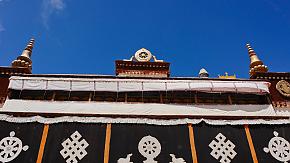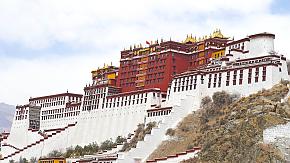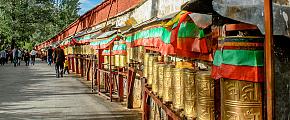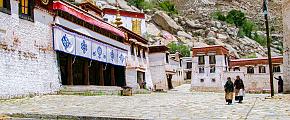Tibetan Culture
People
The people of Tibet are strong, and adaptable due to the harsh environment in which they live, but they are also extremely warm and hospitable. They are always quick to invite a visitor to Tibet into their home and serve them homemade food, and the famous Tibetan butter tea.
Etiquette
Tibet is an ancient place with many unique customs and traditions. Because of this, there are many unique etiquettes and taboos that should be paid attention to by visitors. When entering a temple building, visitors should always remove their hats. Smoking and the consumption of alcohol are also taboo. Do not take photographs inside a temple building without permission. Do not worry about committing a faux pax because there are usually people around who will stop you from doing something wrong. Most Tibetans understand that visitors may not fully understand their traditions and are quite forgiving.
Food
Food, just like Tibetan culture and people has a very distinct character. Tibetan food is not only sustenance but also helps Tibetan people survive the harsh climates. Their food keeps them warm, gives them energy, helps them with the high altitude, and gives them nutrient essentials for the harsh climate. Due to the high altitude of Tibet, water boils at 90 degrees making cooking with water impossible, so Tibetan food has become very specialized. The Tibetan diet consists mostly of meat, milk, and other high-protein foods.
Tsampa: is a staple found at every Tibetan meal. It is a dough made with roasted barley flour and yak butter. There are two basic ways to prepare and eat Tsampa. One is to make dough with Tibetan buttered tea. The other is to make porridge with beef or mutton, and vegetables. The Tsampa dough served with buttered tea is salty, while the porridge is often served with sugar.
Buttered tea: is another staple of Tibetan cuisine. Tibetans drink butter tea because it warms them up. Buttered tea is quite salty. Some people think it tastes more like soup broth than tea.
Beef and Mutton: Tibetans live on beef, mutton, and milk products. Beef and mutton contain high heat energy which is helpful in fighting the cold. Many Tibetans often eat raw meat.
Tibetan noodles: are usually served in a simple vegetable or meat broth.
Momos: are the favorite foods of most visitors to Tibet. They are dumplings made with either meat or vegetables.
 Drepung Monastery, Lhasa
Drepung Monastery, Lhasa
Tibetan Dances
Nearly Every Tibetan can sing and dance. Dancing is an integral part of every Tibetan's life. Tibetan people sing and dance for nearly every event: weddings, funerals, gatherings, and just for fun. There are many different styles of dance. Each area of Tibet has its own distinct style.
The Guoxie (village) dance is a group dance popular in rural Tibet. This dance is usually performed on the open ground from sunrise to sunset. It consists of men and women dancing together in a circle.
Guozhuang (singing and dancing) dance is popular in eastern Tibet. It consists of two parts, singing, and dancing. It is an agile and vigorous dance. Men and women stand in two separate circles and sing in rotation while swaying and stamping their feet. The tempo, in the beginning, is slow and as the song progresses the tempo speeds up. The performers conclude their singing by shouting "Ya!"
Xie (dance) dance is accompanied by a stringed instrument. At festivals and outings, men and women dance the Xie face-to-face in two lines. They are usually directed by one person at the head of their formation who plays a stringed instrument. The participants sing to each other to express their feelings. This dance is graceful and natural characterized by slow steps.
Qamo (sorcerer's) dance is a religious dance. It came to Tibet along with the introduction of Buddhism. It is used to subdue evil spirits in monasteries. Originally the Qamo dance was a mime dance where participants wore ceremonial masks. A traditional livestock-sacrificing ceremony was held. Since the killing of livestock goes against Buddhist doctrine, livestock is no longer killed. Drawings are now substituted. At the end of the dance, the performers take an effigy of Duoma (the leading demon), made of butter and tsampa into the wilderness to burn it, which will drive away evil and bring good fortune in the coming year.
Clothing
Tibetan clothing has a strong connection with the people, and the climate of the "Roof of the World". The Tibetan clothing reflects the history, beliefs, and character of the local people.
Each area of Tibet has its own distinct style of clothing. The clothes are influenced by religion and the environment. Tibetan clothing consists of a robe and shirt. The Tibetan robe worn by men is broad and is normally fastened under the right arm, while the women's are slightly narrower with or without sleeves. The robes are often fastened with two cloth belts. The shirts are also fastened on the right. Men typically wear white shirts with high collars, while women wear various colors with turndown collars.
 Barkhor Street, Lhasa
Barkhor Street, Lhasa
In northern Tibet, the weather is bitterly cold, herdsmen wear a fur-lined robe years round. Their robe also doubles as their quilt at night. Since the day and night temperatures vary greatly, during the day they usually do not put their arms in their sleeves, but rather tie the sleeves around their waist wearing their robe as a kind of skirt. Their fur-lined robes are very bulky and have no pockets, but being fastened at the waist it gives the wearer plenty of room inside to carry daily necessities or even their children.
In pastoral areas, the clothing worn by herdsmen is distinctive for their decorations. Their clothing is usually hemmed in black cloth at the front and lower edges and cuffs. Women wear aprons decorated with colorful cloth stripes.
In the south of Tibet where the weather is warm and damp, the clothing is made from hand-woven woolen cloth. Both men and women button their clothing on the right. Men's clothing is hemmed in colorful cloth, or with silk, while women normally wear sleeveless robes.
In Lhasa, where the weather is warmer and damper many men wear double-layered robes, and women dress in close-fitting robes and long-sleeved shirts, with brightly decorated aprons. The apron is one of Tibetan women's favorite clothing articles. According to custom, the aprons are only worn by married women. It is a privilege that young girls look forward to.
Contact us if you want to explore more of Tibet or other cities in China.
What Our Clients Say
"Great Customized Service", "Trip of A Lifetime", "Exceed All Expectations"





